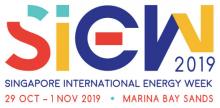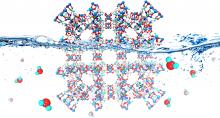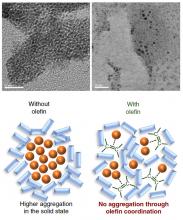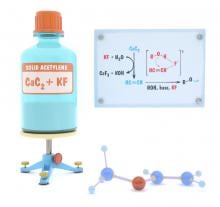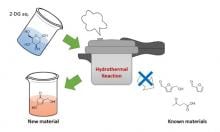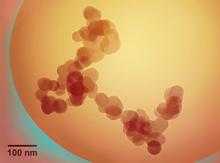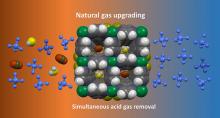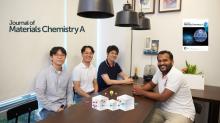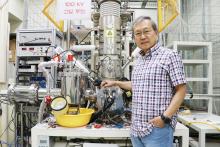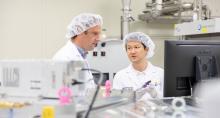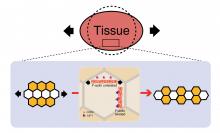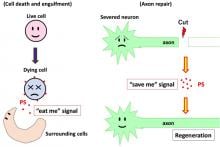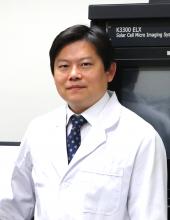Chemistry
News
31 Jul 2019
Now in its 12th edition, the Singapore International Energy Week (SIEW) is a premier platform in Asia for energy insights, partnerships and dialogues, which brings together the world’s leading conferences, exhibitions and roundtables in one week, one location.
17 Jul 2019
A molecule-trapping material that normally degrades in water remains stable after two years of humidity exposure when treated with a common skin bleach.

03 Apr 2019
Chemists use free radicals to produce polymers strong enough to encapsulate drugs while remaining degradable.

11 Mar 2019
Scientists at The Hong Kong University of Science and Technology (HKUST) (HKUST) won three of the seven awards presented by the Croucher Foundation this year.
08 Feb 2019
Adding olefin enables efficient solvent-free cross-coupling reactions, leading to environmentally friendly syntheses of a wide range of organic materials.
08 Feb 2019
Stable, color-changing compound shows potential for electronics, sensors and gas storage.
21 Jan 2019
A team of researchers has developed a system that produces electricity and hydrogen (H2) while eliminating carbon dioxide (CO2).
18 Jan 2019
A safe and sustainable chemical reagent could aid cost-efficient development of new materials and medicines.

18 Jan 2019
Seven faculty members of South Korea's Ulsan National Institute of Science and Technology (UNIST) have distinguished themselves with inclusion in the Global Highly Cited Researchers 2018 List.

17 Jan 2019
South Korea's Ulsan National Institute of Science and Technology (UNIST) held a ceremony to commemorate the completion of Fraunhofer Project Center for Composites Research@UNIST (FPC@UNIST).
15 Jan 2019
Sir Fraser Stoddart, 76, Nobel Prize in Chemistry (2016) and Head of the Stoddart Mechanostereochemistry Group, Department of Chemistry, Northwestern University, will be delivering a lecture on 24th January during the Global Young Scientists Summit (2019) in Singapore.
27 Nov 2018
A compound made from the glycerol by-product of biodiesel production could promote cleaner burning in vehicle engines.
21 Nov 2018
Tohoku University researchers are optimizing methods to produce useful compounds from biomass.
14 Nov 2018
Understanding the effect pressure has on soot production during fuel combustion could help reduce polluting emissions.
30 Oct 2018
A metal-organic framework that selectively removes impurities from natural gas could allow greater use of this cleaner fossil fuel.

12 Oct 2018
Korean researchers have developed new photocatalyst synthesis method using Magnesium hydride (MgH2) and Titanium dioxide (TiO2). The result is expected to contribute to hydrogen mass production through the development of photocatalyst that reacts to solar light.
11 Oct 2018
An international team of researchers , affiliated with South Korea's Ulsan National Institute of Science and Technology (UNIST) has unveiled a novel catalyst that can significantly enhance the performance of perovskite electrodes in Solid Oxide Fuel Cell.
10 Oct 2018
Korean researchers identified the initial growth process of calcium phosphate, a key component of bones, using ‘TOP-MEIS (Time-of-Flight Medium Energy Ion Scattering)’. The research findings differ from existing theories and are expected to be used in research into controlling the growth and characteristics of nanoparticles.

09 Oct 2018
Selected to be a part of the World Premier International Research Center Initiative (WPI) by the Ministry of Education, Culture, Sports, Science and Technology (MEXT) of Japan, Hokkaido University will launch the “Institute for Chemical Reaction Design and Discovery (ICRD)” in October 2018.
09 Oct 2018
New simulations indicate that swirling ammonia in combustion chambers can help reduce harmful emissions – insight that may help on-going efforts to develop ammonia as a carbon-free fuel source.
09 Oct 2018
Tantalum nitride as thin layers improve the extraction of electrons from silicon solar cells.
02 Oct 2018
Chemical analysis of the plant Cosmos caudatus Kunth reveals that it contains substances that can lower blood sugar naturally.
18 Sep 2018
A team of researchers, affiliated with South Korea's Ulsan National Institute of Science and Technology (UNIST) has identified variables that control the cavity-filling rates, required for liquids to penetrate into the cavities.
10 Sep 2018
How cells arrange themselves into precise tissue structures like wings is a response, and a resistance, to global mechanical patterning in a tissue.
07 Sep 2018
Researchers at Nagoya University, Japan, have developed a spontaneous polymer network synthesis that allowed for the preparation of gels containing narrow molecular weight distribution polymers. The gel networks showed swelling properties that were responsive to temperature and solvent concentration.
27 Aug 2018
Researchers at Nagoya University have identified the series of molecules involved in the regeneration of damaged nerves in roundworm, showing that it largely overlaps with the signals used by the intrinsic removal system to take up and process dying cells.
13 Aug 2018
Korean researchers developed high-efficiency photocatalysts that convert carbon dioxide into methane or ethane with graphene-covered reduced titanium dioxide. The finding is expected to be utilized in the carbon dioxide reduction and recycling industries.
01 Aug 2018
Scientists have discovered that an ice-binding protein (fcIBP) from the sea ice microalga does not fit in the conventional classification of ice-binding proteins, suggesting unknown mechanisms behind its antifreeze property. This finding could lead to a broader application of the antifreeze protein in food and medical industries.

02 Jul 2018
A new conceptual model for describing a fuel’s composition can accelerate and simplify combustion simulations.
Events
Sorry, nothing coming up for this discipline
Researchers
Sorry, nothing coming up for this discipline
Giants in history
Sorry, nothing coming up for this discipline


